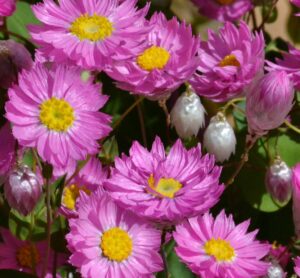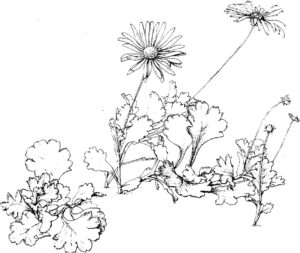
Some people think that native plants are straggly and boring. You only need to look at the beautiful variety of Australia daisies to see that this is just not so . They grow quickly and flower over a long period of time and there is a place for them in every garden.
Australian daisies are members of the Asteraceae family, a diverse family of plants comprising about 20,000 species worldwide. In Australia there are almost 1,000 indigenous species comprising shrubs, sub shrubs, perennial herbs, annuals and a few biennials. Approximately 110 of these occur naturally in the Sydney region . Each daisy has the appearance of a single flower, but is actually composed of up to hundreds of individual flowers. Most have disc florets in the centre and ray florets on the outside.
Daisies are decorative plants and have many uses in the garden as rockery plants, spill over plans on low walls, borders, groundcovers and impots, baskets and window boxes. Using the different forms of Brachyscome multifida, it is possible to create an interesting mosaic of mauves, purples, whites and pinks.
There are too many Australian daisies to generalise about the growing conditions they enjoy. Some prefer full sun, others like shade, some like open conditions, others prefer overhead protection. There are daisies for all soils from clay to sand, wet to dry.

Growth will usually be improved if the soil is well drained, enriched with organic matter (for strong healthy plants) and slightly acid with many daisies. Too much fertiliser can result in weak sappy growth, so apply the fertiliser sparingly.
It is best to purchase plants on the smaller side as they quickly become pot bound and lose their vigour if left growing too long in their pot. Maintenance of woody perennial daisies involves cautious pruning of old wood and it is best to wait until new growth is well established at the base of the plant before pruning away old growth. Failure to do this can result in no new shoots from the old wood, so be patient.
Here are a few examples as guidelines as to daisies which have been found to work well in the region. See our plant database for more information.
Perennial daisies
|
Brachyscome ascendens Brachyscome aculeata Brachyscome angustifolia Brachyscome basaltica var gracilis Brachyscome diversifolia Brachyscome formosa, Brachyscome microcarpa, Brachyscome multifida Brachyscome nova-anglica Brachyscome parvula var parvula Brachyscome sementos Brachyscome tadgelli Calocephalus citreus Calocephalus lacteus Calotis cuneifloia Calotis glandulosa Calotis scapigera |
Cassinia quinquetaria Chrysocephalum apiculatum Chrysocephalum baxteri Helichrysum rutidolepis Leptorhynchos squamatus Leptorhynchos tenuifloius Leucophyta brownie Olearia species Ozothamnus ledifolius Podolepis jaceoides Podolepis rugata Pycnosorus chrysantus Pychnsorus globosus Rhodanthe anthemoides Xerochrysum braceatum Xerochrysum papillosum Xerochrysum subundulatum Xerochrysum viscosum |
Annual daisies
|
Brachyscome bellidiodes Brachyscome iberidifolia Hyalosperma cotula Hyalosperma praecox Hyalosperma simplex Podolepis lessonii |
Rhodanthe chlorocephala subsp rosea Rhodanthe diffusa subsp diffusa Rhodanthe humboldtiana Rhodanthe manglesii Schoenia filifolia subsp filifolia |
Here’s a PDF of this story: Reliable daisies for the Sydney region
